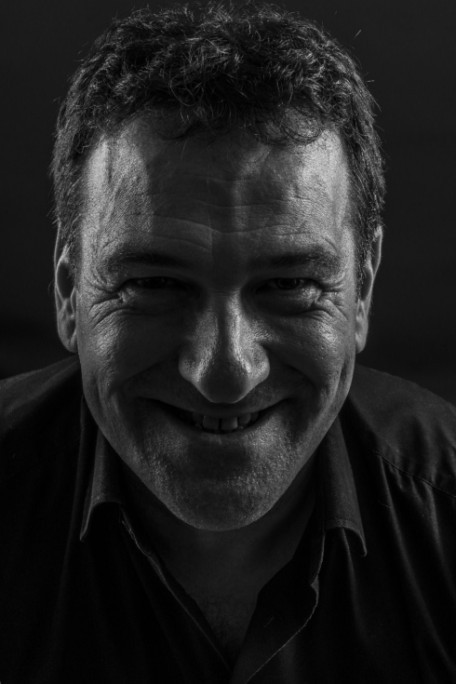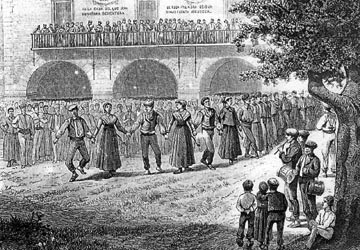01 - 12 kilo - 3´23
('12 kilos')
(Music: Alan Griffin)
(Arranged
& produced by Joxan Goikoetxea
& Alan Griffin)
Recording engineer: Joxan Goikoetxea
Recorded at Aztarna Studio (Hernani, Gipuzkoa) throughout 2017
Mixing
and Digital Mastering:
Mikel F.Krutzaga – Musikart Studio (Amezketa - Gipuzkoa)
Alan
Griffin:
whistle, alboka & Jew's-harp
Joxan Goikoetxea: accordion,
programming
Fiachra Mac Gabhann: bouzouki
& mandolin
Peter Maund: târ
& riqq
Juan Arriola: fiddle
This is a new arin-arin, a social dance in 2/4 time which is very popular in much of the Basque Country.
It's Nº 40 in Alan's book of alboka tunes Halfway to Hell: Albokarako 333 doinu.

I
In Halfway to Hell I explain the title of this tune as follows:
'When I first began playing music with Joxan Goikoetxea the twelve kilos
of his accordion represented a fifth of his body weight. Over the intervening
twenty-five years these proportions have changed somewhat, making his
Cavagnolo relatively lighter nowadays. Not that this stops him from
complaining.'
I laboriously prepared a demo of this tune, arranged as a kind of 'duelling
banjos', between the accordion and alboka. Joxan received it in silence
(a dangerous sign). I laid down the track and went to Ireland. When
I came back I found the present version was nearly complete.
And yes, Part D of the tune is modelled on 'Johnny Maguire's
Reel', or 'The Glass of Beer', or 'John Stenson's Nº 2', or whatever
they call it where you play your music. I knew this when I was doing
it: it's meant to be a bit of fun.
Just
as we were finishing these
notes to the tracks we were shocked
to hear of the tragic death of our friend
Fiachra Mac Gabhann,
who had worked closely with
us on Lurra, ur, haize and another
two Alboka albums, Lorius (2000)
and Lau anaiak (2004), and who had
often played in concert with us.
His
energetic and unmistakeable
bouzouki and mandolin style were
integral to the Alboka sound.
We dedicate this album to his memory.
A native of Blackrock, Co. Louth,
Fiachra had lived for many years
in Partry, Co. Mayo, where the
local community are stunned
by his untimely death.
He taught Irish at
Castlebar College of Further Education
and was the author of
a comprehensive 10-volume study
of the place-names of Co. Mayo,
Logainmneacha Mhaigh Eo,
the longest book ever to be
published in the Irish language.
As his friends, colleagues and
students have emphasised,
he was a man of great talent,
a committed teacher and passionate about Irish culture,
language and music, to which
his contribution was immense.
Ar dheis Dé go raibh a anam dílis
t
won’t be at all easy to keep
the humorous
and chirpy tone we habitually use in our
notes to album tracks, but perhaps
it’s the best way to pay tribute to you,
Fiachra, who so enjoyed banter
in your gentle way,
with your permanent smile.
Bon voyage, friend!
Back
to main menu
The style and layout of this arin-arin led me almost subconsciously
to envisage an arrangement like 'Hi zelta!' on Lorius
(2000). Nor did it take long for me to see that it would make
a suitable opening track for the album.
We apologise to purists for separating this arin-arin from
its habitual dancing-companion the fandango.

In fact, since we were lucky
enough to have Fiachra to hand, it seemed better to deal with the arin-arin
separately. The opening bars on his mandola are typical
of the character and colour he lends to our last three albums. It was
also a joy to play again with Alboka ex-member Juan Arriola, who always
lifted our spirits. And what can I say about the noble and distinguished
Peter Maund? If California weren’t so far away...
It’s so easy to make music with people like this, and such a pleasure.
When
I saw that Alan's comments on the tune in his book Halfway to Hell
made reference to me in Irish Gaelic, two thoughts came into my mind:
(a) that the comment wasn't exactly complimentary, and (b) he didn't
want me to understand it.
My current weight-age relationship with the accordion still allows me
to play it. If the development had been the other way round what might
have happened?